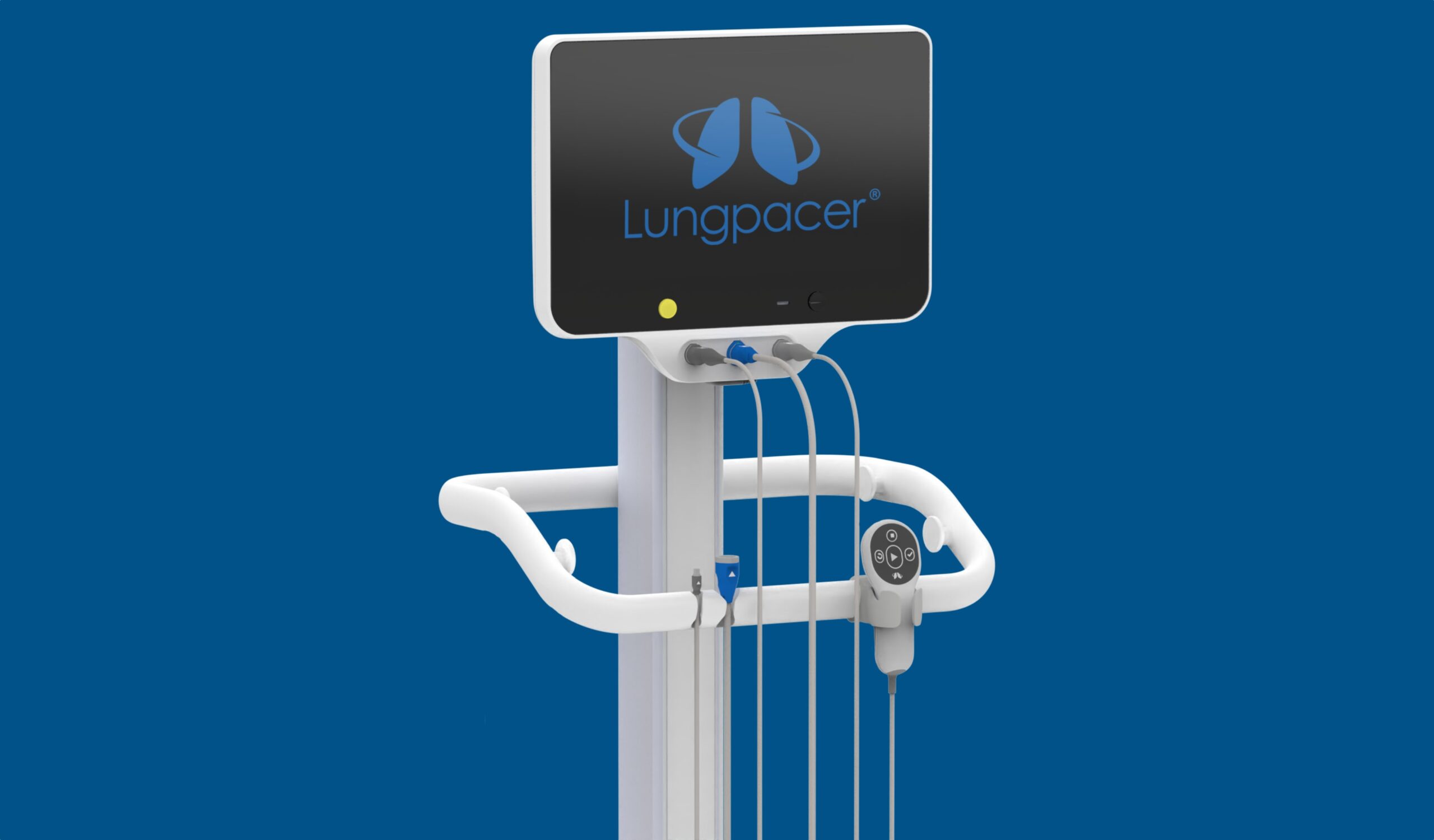Studying faster ventilator independence with minimally invasive diaphragm strengthening technology
FOR IMMEDIATE RELEASE
Exton, PA – February 14, 2022 – Lungpacer Medical, a leading medical device innovation company, today announced the introduction of the AeroPace™ System, a next generation product, into the RESCUE 3 pivotal clinical study studying faster ventilator independence. Lungpacer is dedicated to natural breathing by developing minimally invasive technologies designed to help patients wean off mechanical ventilation and breathe on their own. The RESCUE 3 study is the third in a series of studies to support FDA and international regulatory approvals.
Lungpacer therapy has a Breakthrough Device designation and Emergency Use Authorization from the FDA. An abstract presented at the 2021 American College of Chest Physicians Annual Conference discussing Lungpacer therapy use on patients with COVID-19 under EUA reports that the therapy may assist in earlier liberation from mechanical ventilation. Outcomes from a previous Lungpacer clinical study published in theFebruary 2022 edition of the American Journal of Respiratory Critical Care Medicine showed Lungpacer therapy strengthened the diaphragm 246% more, and improved lung function 128% more than patients who did not receive the therapy.[1]
The growing body of research including more than 44 scientific presentations and 11 peer reviewed publications is building evidence and data to demonstrate the value of AeroPace therapy. Lungpacer CEO Doug Evans stated, “The emerging research profile of AeroPace underscores the clinical potential of this therapy to play a meaningful role to limit the negative impacts of mechanical ventilation and restore strength for patients to achieve ventilator independence. Once approved, the AeroPace system has the potential to dramatically improve the standard of care and transform the future of ventilation.”
Without a strong diaphragm it is impossible to breathe independently[2] and artificial breathing support from a mechanical ventilator may weaken the diaphragm muscle more than 50% in one day.[3] By delivering small stimulations to targeted nerves in the upper body to activate the diaphragm, the AeroPace System acts as a “personal trainer” for the diaphragm muscle. These daily, repetitive exercises are designed to build diaphragm strength and empower independent breathing, freeing patients from the trauma of mechanical ventilation.
For the clinician, AeroPace provides easy setup for convenient patient therapy and ECG-guided catheter placement, streamlining the clinical workload. For the patient, automated electrode mapping, variable stimulation settings to adjust exercise intensity, and advanced patient synchrony with stimulation up to every breath are designed to customize therapy delivery and cater to patient comfort to accelerate the ventilator weaning process.
Dr. Steven Conrad, Professor and Division Chief at Ochsner LSU Health and RESCUE 3 study Principal Investigator, noted, “The ability for the new AeroPace catheter to be placed either in the subclavian or jugular vein allows clinicians to utilize the best possible access for the patient as well as for therapeutic outcomes. We expect the automated mapping and therapy delivery features to cut our treatment time in half. AeroPace is a great new system, and we look forward to utilizing this technology more in the future.”
More than 40 highly respected medical centers in the U.S., Germany, France, and Spain are currently participating in the pivotal RESCUE 3 trial studying faster ventilator independence with the Lungpacer therapy. Dr. Joseph Shrager of participating clinical site Stanford University School of Medicine said, “Lungpacer therapy provides an exciting potential solution to help mechanically ventilated patients return to natural breathing more quickly.”
Lungpacer was recently recognized by The Cardiovascular Research Foundation (CRF) as the winner of the Transcatheter Cardiovascular Therapeutics (TCT) 2021 Shark Tank Innovation Competition for the Lungpacer System’s “great potential to not only save the lives of countless critically sick patients but also completely change the treatment paradigm for those needing mechanical ventilation.”
About Lungpacer Medical and AeroPace
Lungpacer Medical is dedicated to natural breathing by developing minimally invasive technologies designed to help patients wean off mechanical ventilation and breathe on their own. Lungpacer’s AeroPace System is designed to stimulate the nerves that activate and exercise the diaphragm to rebuild diaphragm strength and empower natural, independent breathing. AeroPace may potentially help the nearly 2 million patients that require mechanical ventilation every year, accounting for up to $96 billion annually in direct care costs. Learn more at Lungpacer.com and connect on LinkedIn, Twitter, and YouTube.
Contact: media@lungpacer.com
CAUTION: Investigational Device. Limited by Federal law (United States) to investigational use. Used exclusively for clinical investigations.
Emergency Use Authorization. The Lungpacer System is authorized for emergency use in healthcare settings to assist in weaning patients determined by their healthcare provider to be at high risk of weaning failure off ventilators during the COVID-19 pandemic. The Lungpacer System has neither been cleared nor approved for the indication to assist in weaning patients off ventilators in healthcare settings during the COVID-19 pandemic; the Lungpacer System has been authorized for the above emergency use by FDA under an EUA; the Lungpacer System has been authorized only for the duration of the declaration that circumstances exist justifying the authorization of the emergency use of medical devices under section 564(b)(1) of the Act, 21 U.S.C. § 360bbb-3(b)(1), unless the authorization is terminated or revoked sooner.
[1] Dres, M., et al. Randomized Clinical Study of Temporary Transvenous Phrenic Nerve Stimulation in Difficult-to-Wean Patients, AJRCCM 2022 Feb 2. doi: 10.1164/rccm.202107-1709OC: 246% stronger diaphragm (MIP)/P=0.0010; +7.4% increased ventilator independence/P=0.586; 7.9% greater survival /P=0.216; 1.4 days less dependent on a ventilator/p=0.498. Modified Intent to Treat Subset (mITT), 128% improved lung function (RSBI)/P=0.102, Modified Intent To Treat Subset (mITT). 167% improved lung function (RSBI)/P=0.0487 in Per Protocol (PP) group received at least 50% of Lungpacer therapy sessions.
[2] Jubran A, Tobin MJ. Pathophysiologic basis of acute respiratory distress in patients who fail a trial of weaning from mechanical ventilation. Am J Respir Crit Care Med. 1997-155:906-15. doi: 10.1164/ajrccm.155.3.9117025.PMID:9117025.
[3] Levine S, et al. Rapid Disuse Atrophy of Diaphragm Fibers in Mechanically Ventilated Humans. N Engl J Med. 2008 27 Mar: 358(13): 1327-35. doi: 10.1056/NEJMoa070447. PMID: 18367735.

